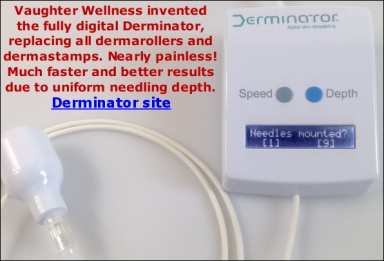Yes, first Betadine and then a numbing cream. You can also wash off the numbing cream with tap water (and a cotton pad). I will change it in our instructions.
I paste here what I wrote in another thread. Perhaps it is interesting for you:
Disinfecting the dermaneedling instrument after dermarolling is more
important than disinfecting the skin before dermarolling. Of prime
importance is to clean the instrument after dermaneedling with dishwashing
detergent and warm water (not boiling water) and rinsing it under a strong
stream of water to remove blood and skin detrius from the needles. Then soak
it in Chloramine-T or Ethanol. This prevents the formation of potentially
harmful bacteria while the instrument is not used. The bacteria on your skin
are much less dangerous that what can form when you don't clean a
dermaneedling instrument.
Basically, if you do not clean a dermaroller, what forms on the roller head
and needles are the same bacteria as that in a rotting corpse. Whereas the
bacteria on the skin are totally different bacteria, it's more of a stabile
ecosystem of probiotic bacteria, a protective layer of beneficial bacteria
on your skin, a great majority of beneficial bacteria that prevent bad
bacteria and harmful fungi from getting a foothold.
Your immune system has plenty of antibodies against the bacteria on your
skin, aquired whenever you cut or chafed yourself. The same goes for active
acne. Every time you squeeze a pimple, some bacteria enter your bloodstream
and you make antibodies against them. Therefore, even if you "roll in" a lot
of bacteria from your skin, there is only a very tiny chance that an
infection can result.
So the main thing is to clean your roller after use with water and
dishwashing liquid, to get rid of the "big chunks" (only visible under a
microscope though) of skin detrius and body oils. That would in principle
already be sufficient, but just to be totally on the safe side we also
disinfect the roller in Ethanol. If you want to be absolutely sure that your
roller is totally sterile like an operating scalpel straight from its
packaging in a hospital, then instead of Ethanol, use our Chloramine-T.
Chloramine-T kills bacteria like antibiotics do. Chloramine-T has in fact a
double antibiotic mechanism of action. And it is cheaper than alcohol as
well - from us at least.
Finally, I want to say that we had tens of thousands of customers over the
past years and that we never heard of anyone getting an infection - ever.
And that's because of what I already explained: "Rolling in" the bacteria on
your own skin is in fact quite safe. And simply cleaning the roller well
with water and a soapy substance is also sufficient, in practice. That means
that disinfecting the skin and roller is actually overkill, and hence nobody
ever reported an infection.
Anyone who still is worried about infections should soak the instrument
overnight in a Chloramine-T solution and the result is total sterilization.





